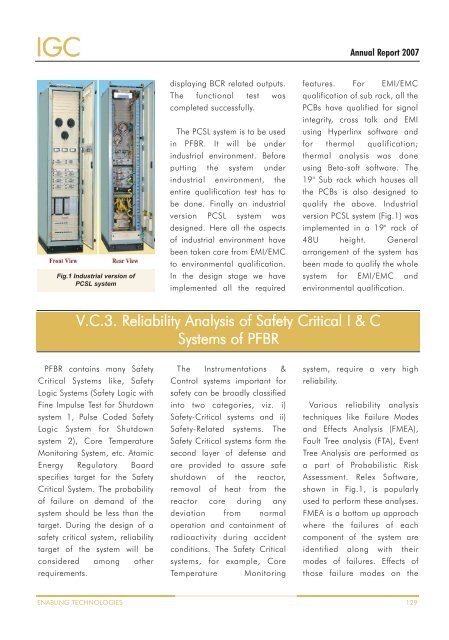IGCAR : Annual Report - Indira Gandhi Centre for Atomic Research
IGCAR : Annual Report - Indira Gandhi Centre for Atomic Research
IGCAR : Annual Report - Indira Gandhi Centre for Atomic Research
You also want an ePaper? Increase the reach of your titles
YUMPU automatically turns print PDFs into web optimized ePapers that Google loves.
IGC<br />
<strong>Annual</strong> <strong>Report</strong> 2007<br />
Fig.1 Industrial version of<br />
PCSL system<br />
displaying BCR related outputs.<br />
The functional test was<br />
completed successfully.<br />
The PCSL system is to be used<br />
in PFBR. It will be under<br />
industrial environment. Be<strong>for</strong>e<br />
putting the system under<br />
industrial environment, the<br />
entire qualification test has to<br />
be done. Finally an industrial<br />
version PCSL system was<br />
designed. Here all the aspects<br />
of industrial environment have<br />
been taken care from EMI/EMC<br />
to environmental qualification.<br />
In the design stage we have<br />
implemented all the required<br />
features. For EMI/EMC<br />
qualification of sub rack, all the<br />
PCBs have qualified <strong>for</strong> signal<br />
integrity, cross talk and EMI<br />
using Hyperlinx software and<br />
<strong>for</strong> thermal qualification;<br />
thermal analysis was done<br />
using Beta-soft software. The<br />
19" Sub rack which houses all<br />
the PCBs is also designed to<br />
qualify the above. Industrial<br />
version PCSL system (Fig.1) was<br />
implemented in a 19" rack of<br />
48U height. General<br />
arrangement of the system has<br />
been made to qualify the whole<br />
system <strong>for</strong> EMI/EMC and<br />
environmental qualification.<br />
V.C.3. Reliability Analysis of Safety Critical I & C<br />
Systems of PFBR<br />
PFBR contains many Safety<br />
Critical Systems like, Safety<br />
Logic Systems (Safety Logic with<br />
Fine Impulse Test <strong>for</strong> Shutdown<br />
system 1, Pulse Coded Safety<br />
Logic System <strong>for</strong> Shutdown<br />
system 2), Core Temperature<br />
Monitoring System, etc. <strong>Atomic</strong><br />
Energy Regulatory Board<br />
specifies target <strong>for</strong> the Safety<br />
Critical System. The probability<br />
of failure on demand of the<br />
system should be less than the<br />
target. During the design of a<br />
safety critical system, reliability<br />
target of the system will be<br />
considered among other<br />
requirements.<br />
The Instrumentations &<br />
Control systems important <strong>for</strong><br />
safety can be broadly classified<br />
into two categories, viz. i)<br />
Safety-Critical systems and ii)<br />
Safety-Related systems. The<br />
Safety Critical systems <strong>for</strong>m the<br />
second layer of defense and<br />
are provided to assure safe<br />
shutdown of the reactor,<br />
removal of heat from the<br />
reactor core during any<br />
deviation from normal<br />
operation and containment of<br />
radioactivity during accident<br />
conditions. The Safety Critical<br />
systems, <strong>for</strong> example, Core<br />
Temperature Monitoring<br />
system, require a very high<br />
reliability.<br />
Various reliability analysis<br />
techniques like Failure Modes<br />
and Effects Analysis (FMEA),<br />
Fault Tree analysis (FTA), Event<br />
Tree Analysis are per<strong>for</strong>med as<br />
a part of Probabilistic Risk<br />
Assessment. Relex Software,<br />
shown in Fig.1, is popularly<br />
used to per<strong>for</strong>m these analyses.<br />
FMEA is a bottom up approach<br />
where the failures of each<br />
component of the system are<br />
identified along with their<br />
modes of failures. Effects of<br />
those failure modes on the<br />
ENABLING TECHNOLOGIES 129

















